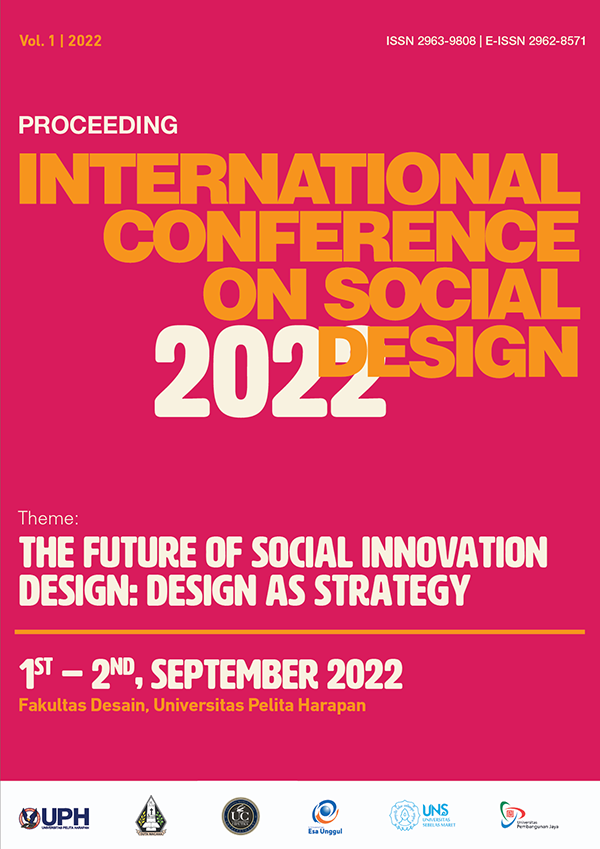Social Housing for Social Design in Indonesia (A Case of Dupak Bangunrejo, Surabaya)
Abstract
A social housing addresses informal settlements for low-income households in urban areas. This study aims to analyze social housing related to social design theories in order to determine the products and services. In addition, this study establishes social problems which are trying to be solved by social housing as a social design. Dupak Bangunrejo, a three-story, was selected as the research subject. A qualitative descriptive method was conducted to observe and analyze the social design for products and services. Products are determined as units, public spaces (outdoor and indoor), balconies, communal showers, and kitchens. Services are clean water, electricity, waste management, and security system. Furthermore, this study establishes that social housing was built due to the growth of informal settlements in urban areas and ultimately affects the environment, such as urban sprawl, waste disposal, water and air pollution, and public diseases. In conclusion, Dupak Bangunrejo social housing as a social design product was built to address the social problems and to support occupants’ behavior alteration.
References
Antonelli, P. (2013). Why I brought Pac-man to MoMA. TEDSalon NY2013, 18, 42.
Armstrong, L., Bailey, J., Julier, G., & Kimbell, L. (2014). Social design futures: HEI research and the AHRC.
Aryani, N. P., & Jen-Tu, K. (2020). Environmental Behavior Analysis of Social Housing Units in Surabaya, Indonesia. Journal of Asian Architecture and Building Engineering. https://doi.org/DOI: 10.1080/13467581.2020.1799796
BPS Kota Surabaya. (2020). Proyeksi Penduduk Kota Surabaya.
Chen, D.-S., Cheng, L.-L., Hummels, C., & Koskinen, I. (2016). Social design: An introduction. International Journal of Design, 10(1), 1-5. Hanks, P. (1979). Collins dictionary of the English language.
Indahri, Y. (2017). Tantangan Pengelolaan Penduduk di Kota Surabaya. Aspirasi: Jurnal Masalah-Masalah Sosial, 8(1), 1-11.
ITS, P. S. (2015). Identifikasi Rumah Susun Sederhana Sewa di Surabaya.
Kisnarini, R. (2015). Functionality and adaptability of low cost apartment space design: a case of Surabaya Indonesia. Technische Universiteit Eindhoven.
Kisnarini, R., Post, J., Ligny, E. van E. de W. de, & Mohammadi, M. (2015). Providing Adaptability of Space to Ensure Sustainable Living in Low Cost Housing in Indonesia. Procedia - Social and Behavioral Sciences. https:// doi.org/10.1016/j.sbspro.2015.02.425
Kisnarini, R., van Egmond, E., & Mohammadi, M. (2012). Importance of Functionality in Realizing Sustainability of Low Cost Apartments in Surabaya, Indonesia. Architecture and Urban Planning, Vol.6:31, 31-36. https://doi.org/10.7250/ aup.2012.005
Margolin, V., & Margolin, S. (2002). A” Social model” of design: issues of practice and research. Design Issues, 18(4), 24-30.
Moleong, L. J. (2007). Metodologi penelitian kualitatif edisi revisi.
Papanek, V., & Fuller, R. B. (1972). Design for the real world.
Pearce, P. (1980). Structure in Nature is a Strategy for Design. MIT press.
Rachmawati, F., Soemitro, R. A. A., Adi, T. J. W., & Susilawati, C. (2015). Low-cost apartment program implementation in Surabaya metropolitan area. Procedia Engineering, 125, 75-82. https://doi.org/10.1016/j.proeng.2015.11.012
Silas, J. (1990). Rumah Susun Sewa Dupak Bangunrejo Surabaya. Pemerintah Daerah Tingkat II Kotamadya Surabaya collaborated with Housing and Human Settlement Laboratory of Institut Teknologi Sepuluh Nopember ITS, Surabaya-Indonesia.
Silas, J. (2019). Surabaya. The Wiley Blackwell Encyclopedia of Urban and Regional Studies, 1-4.
Tromp, N. (2013). Social Design: How products and services can help us act in ways that benefit society.
Tromp, N., & Hekkert, P. (2018). Designing for society: Products and services for a better world. Bloomsbury Publishing.
Vial, S. (2014). What is called ”˜Social Design’? A Matter of Design, 5th STS Italia Conference.
Warouw, F., Kobayashi, H., & Jung, J. (2010). A Study on the Open Building System for Multi-Storey Housing in Indonesia. Journal of Asian Architecture and Building Engineering, Vol.9(No.2), Page 339-346. https://doi.org/10.3130/ jaabe.9.339
Whiteley, N. (1993). Design for society. Reaktion books.
Wood, E. (1961). Housing design: A social theory. Ekistics, 12(74), 383-392.
Yee, J., & White, H. (2016). The Goldilocks Conundrum: The ”˜just right’conditions for design to achieve impact in public and third sector projects. International Journal of Design, 10(1).





1.png)
